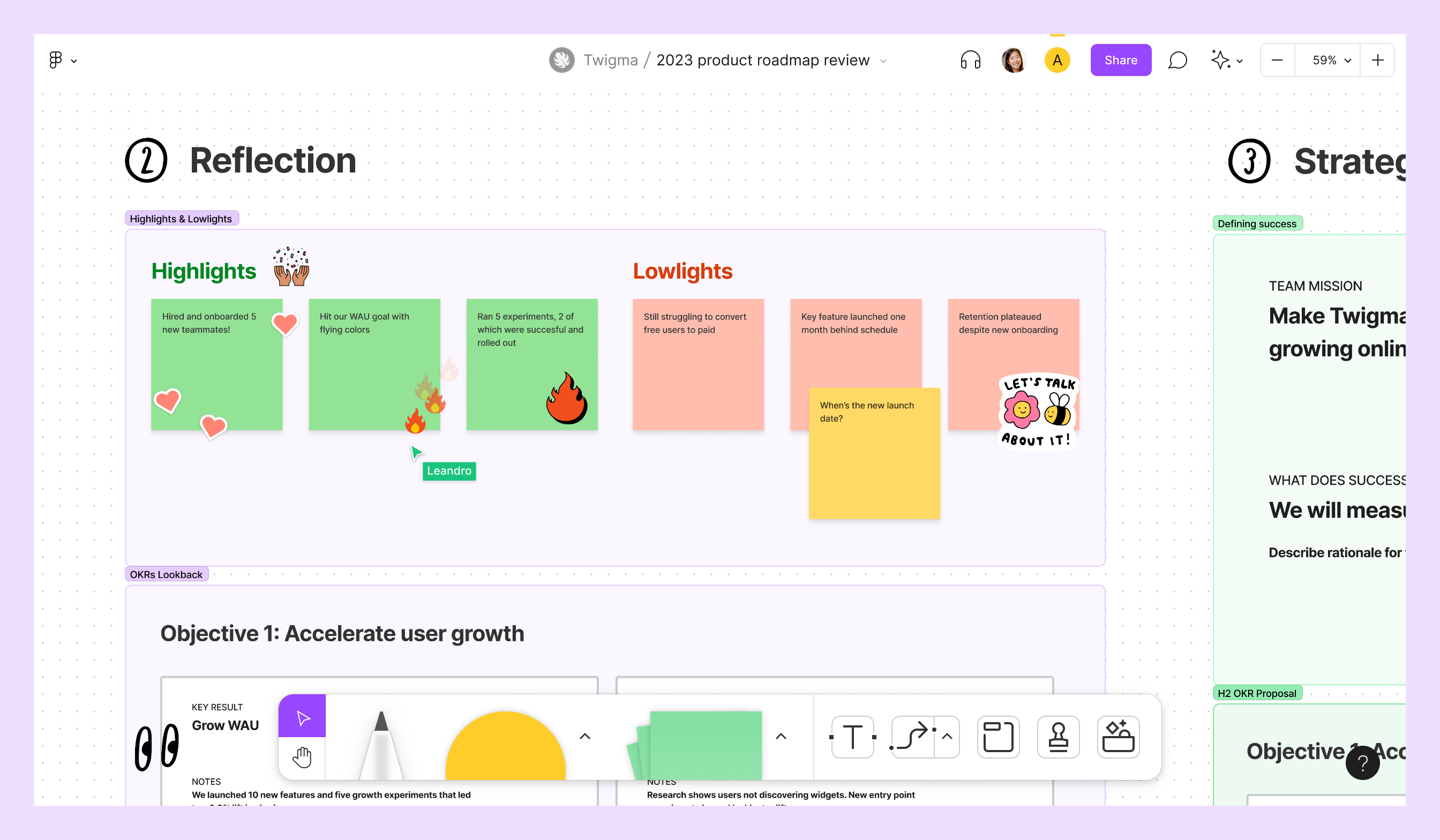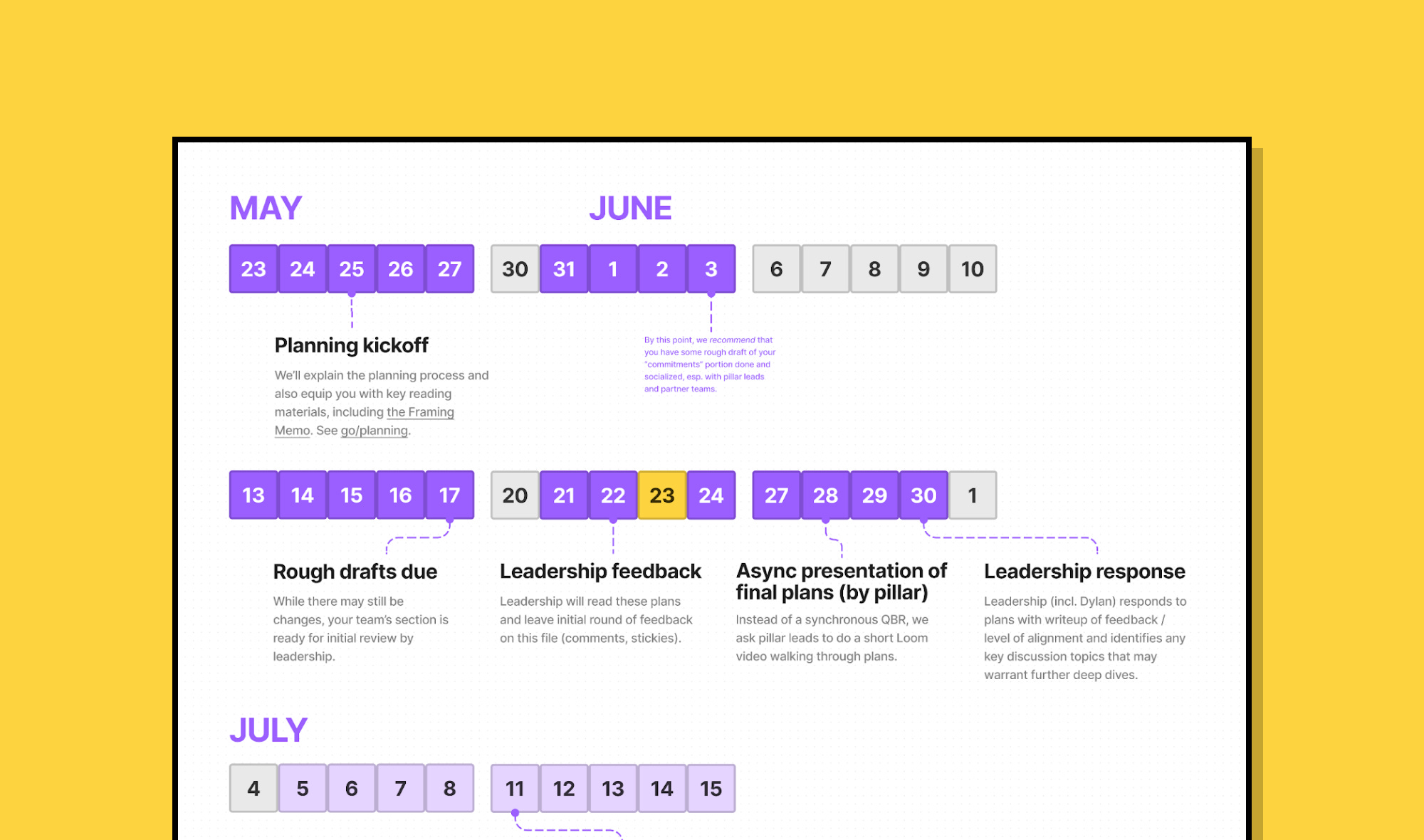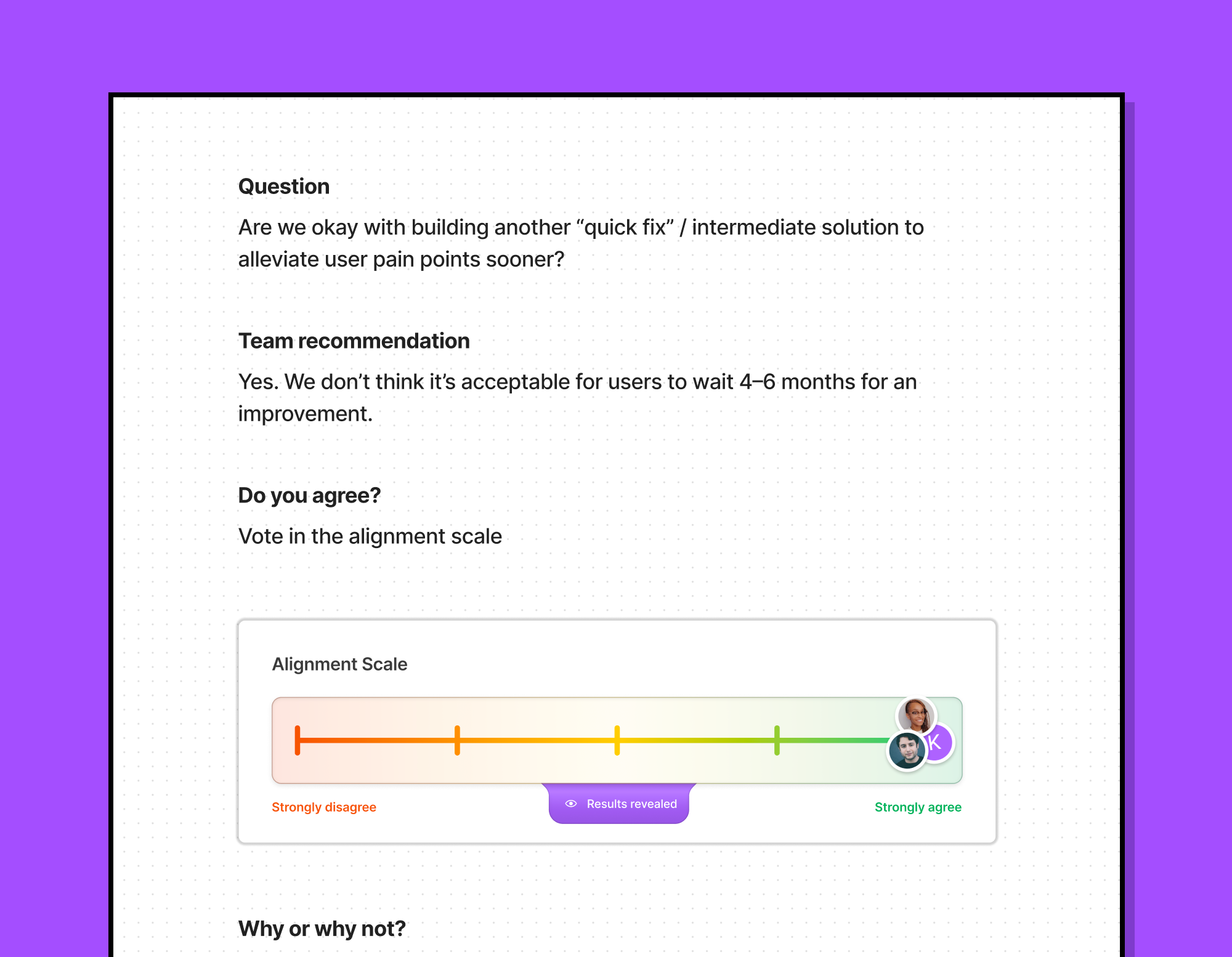Lenny's Newsletter - How Figma builds product
Below is a peek at today’s subscriber-only post. Subscribe today and get access to this issue—and every issue. How Figma builds productYuhki Yamashita, Chief Product Officer at Figma, shares lessons learned, plug-and-play templates, and fresh insights into how Figma builds product👋 Hey, I’m Lenny and welcome to a 🔒 subscriber-only edition 🔒 of my weekly newsletter. Each week I tackle reader questions about product, growth, working with humans, and anything else that’s stressing you out about work. I’m kicking off a new series where I share how the most effective product teams build product. I’m often asked how to structure one’s product development process. What better way to learn than by studying best-in-class companies? I’m excited to launch this series with Figma, one of the most innovative, interesting, and impactful product teams today. I reached out to Yuhki Yamashita, Chief Product Officer at Figma, and he very kindly agreed to answer my (many) questions. As CPO, Yuhki leads the product and design teams at Figma. Before joining Figma, he was at Uber for over four years, where he led the redesign of both the rider and driver apps. Prior to that, at Google, he was responsible for the YouTube app on iOS. Thank you for sharing, Yuhki 🙏 How Figma builds product1. How far out do you plan in detail, and how has that evolved over the years?Every year, the leadership team sets high-level company priorities to frame key strategic investments. It’s then up to product teams to chart out the path to reach those goals. A bigger planning cycle happens twice a year, with product teams revisiting their own goals and roadmaps. Halfway through each half—or in the alternating quarters—teams have an opportunity to adjust those plans based on learnings and new information. Planning cycles haven’t changed too much over the years. They’ve been roughly quarterly in the beginning, but over time, we began formalizing things a bit more, where there was a cadence for different altitudes (annual company priorities, larger half planning, and quarterly refreshes/adjustments). Here’s a link to our Roadmap Review Template on FigJam, which is essentially how we do planning: I partner with Lawrence Luk (our Technical Program Manager) on leading the planning process. Lawrence comes up with the process, and together we handle the comms and implementation. 2. Do you use OKRs (e.g. objectives, key results, 70% goals, etc.) in some form?We’ve had a fun relationship with OKRs. When I first arrived at Figma, I actually deprecated OKRs. We had dreadful companywide OKR meetings where we went through a spreadsheet tracker of hundreds of OKRs that were really more like tasks assigned to individual contributors. While it was good at creating some level of accountability, it was hard to understand why any of this mattered. I asked teams to instead define headlines—essentially, claims that they’d like to make by the end of some time period. For example, it might be something like “Figma is the most efficient way to design,” and the team offers both quantitative and qualitative ways to evaluate that claim. This helped me understand what a team was philosophically going for. It produced the right debates, and it allowed teams to be a bit more creative around how to measure whether they’ve achieved that headline (e.g. a combination of a variety of metrics and qualitative signals). It recognized the reality that some things, like the core experience of Figma, are hard to measure and can’t be reduced to a single metric; it gave room for teams to invest in a roadmap of exploring different KPIs versus artificially elevating a metric that ultimately people didn’t believe actually mattered. Once we hired a data-science leader, we brought OKRs back and have iterated on this format a bit. In some areas, we’ve become more sophisticated with metrics. In other areas, they still can be a bit more qualitative. Importantly, we’ve tried to keep constructs that allow for us to check on the philosophical alignment. And we’ve played around with branding OKRs more as a “commitment” to make sure that teams actually felt responsible for achieving these goals (versus it just feeling like the technical measurement of success but not something teams are indexed on day-to-day). Our OKR process is actually run on FigJam. We have teams write “commitments” (our rebranded OKRs) in these widgets that Lawrence made: 3. How do your product/design review meetings work?We have design crits and product reviews. Design crits are intended to be very generative, and are explicitly not about making decisions. Designers share a file (often on FigJam), and we spend 10 minutes heads-down silently leaving stickies and comments to give feedback on the designs before discussing live. Product reviews are more about making decisions and debating directions. Here’s our template. We have different kinds: ones where we’re trying to align on the problem or ones where we’re trying to align on the solution. One thing I encourage for both is to first present the “option space”—it’s really powerful to have a framework that maps all possible solutions or problems and use that as a device to discuss high-level tradeoffs or philosophical differences. It’s been interesting to see the evolution of the format. When I arrived, people were projecting docs and there was more of a memo culture. I switched this format to decks, mostly because I wanted to push for more of a storytelling culture (and also so my PMs can use Figma more!). And recently we’ve been using FigJam more, because it allows for more of a two-way conversation and it’s easier to gauge people’s reactions. My favorite is adding the alignment widget, which lets people share/vote on their sentiments toward specific decisions; I find this so much more powerful than allowing the loudest people in the room to dictate the outcome!
4. For design crits, who comes to these meetings, who runs the meeting, and how often do you meet?Crits are a central part of our design culture at Figma. We have five standing slots each week, and attendance increases in size with each session over the week (e.g. Tuesdays are for tech pillars, Thursdays for Editor and Non-Editor teams, and Fridays are for all of design). Designers have control over booking them and inviting any additional teammates (beyond the pillars or teams already in attendance). We send out an automated reminder each week in Slack for sign-ups. For the larger crits, we also welcome guest “observers” from across the company. We believe it’s important for everyone to see how designers share ideas and offer feedback on projects. We encourage every employee to attend at least one crit per year, regardless of their role or position. Our crits are fairly structured, following a similar format and led by the presenting designer. Typically we get to two topics per meeting, with a rough agenda of:
We find that this format gives presenters a greater breadth of feedback, while offering a few different entry points for attendees. For more about crits, our Vice President of Design Noah Levin wrote about our process here, as well as presented it here. 5. For product reviews, same question.These include all of product leadership, including Dylan Field, our CEO; project leads; and key decision makers. They happen somewhat ad hoc, but generally at critical milestones in a product’s lifecycle, and are typically facilitated by the PM whose product or work is being reviewed. 4. How many PMs do you have?Twenty-two, and we’re hiring! 5. Do you structure your product teams around products, user types, user journey, outcomes, or something in between? Has this changed over the years?This is also a fun debate! Right now, we organize around products and platforms. We have two products—Figma Design and FigJam—so we have two teams solely focused on the respective product. We then have “horizontal” platform teams that build features and solve problems across both products, e.g. the “Enterprise” group that focuses on making both of these products amazing for large enterprises and the “Infrastructure” group that ensures the reliability and performance of both products. This has changed a bit over the years, especially when we were a single-product company. At the time, teams were organized more around product surfaces (which roughly corresponded to use cases). Solving team structure is an art, not a science, and something that we expect to revisit continually as we grow. 6. Are product and design part of the same org? Who do PMs ultimately report to, and has this changed over the years?...Subscribe to Lenny's Newsletter to read the rest.Become a paying subscriber of Lenny's Newsletter to get access to this post and other subscriber-only content. A subscription gets you:
|
Older messages
An inside look at how the New York Times builds product | Alex Hardiman (CPO at The New York Times)
Sunday, November 13, 2022
Listen now (67 min) | Alex Hardiman is Chief Product Officer at the New York Times, where she oversees the company's news, cooking, games, audio and advertising products. Previously, Alex was Chief
Sign in to Lenny's Newsletter
Friday, November 11, 2022
Here's a link to sign in to Lenny's Newsletter. This link can only be used once and expires after 24 hours. If expired, please try logging in again here. Sign in now © 2022 2443 Fillmore St., #
How to fire people with grace, work through fear, and nurture innovation | Matt Mochary (CEO coach)
Thursday, November 10, 2022
Listen now (71 min) | Matt Mochary is a full-time executive coach who has worked with some of the biggest names in tech, including investor Naval Ravikant and the CEOs of Notion, OpenAI, Rippling,
How to determine your activation metric
Tuesday, November 8, 2022
Including a deep dive into multi-player B2B SaaS products, featuring Figma, Linear, Snyk, Airtable, Slack, and Asana
How Snyk built a product-led growth juggernaut | Ben Williams (VP of Product at Snyk)
Sunday, November 6, 2022
Listen now (92 min) | Ben Williams is VP of Product at Snyk, an industry-leading security platform for developers, last valued at $8.5b. He's also a product and growth advisor with over 20 years of
You Might Also Like
🚀 Ready to scale? Apply now for the TinySeed SaaS Accelerator
Friday, February 14, 2025
What could $120K+ in funding do for your business?
📂 How to find a technical cofounder
Friday, February 14, 2025
If you're a marketer looking to become a founder, this newsletter is for you. Starting a startup alone is hard. Very hard. Even as someone who learned to code, I still believe that the
AI Impact Curves
Friday, February 14, 2025
Tomasz Tunguz Venture Capitalist If you were forwarded this newsletter, and you'd like to receive it in the future, subscribe here. AI Impact Curves What is the impact of AI across different
15 Silicon Valley Startups Raised $302 Million - Week of February 10, 2025
Friday, February 14, 2025
💕 AI's Power Couple 💰 How Stablecoins Could Drive the Dollar 🚚 USPS Halts China Inbound Packages for 12 Hours 💲 No One Knows How to Price AI Tools 💰 Blackrock & G42 on Financing AI
The Rewrite and Hybrid Favoritism 🤫
Friday, February 14, 2025
Dogs, Yay. Humans, Nay͏ ͏ ͏ ͏ ͏ ͏ ͏ ͏ ͏ ͏ ͏ ͏ ͏ ͏ ͏ ͏ ͏ ͏ ͏ ͏ ͏ ͏ ͏ ͏ ͏ ͏ ͏ ͏ ͏ ͏ ͏ ͏ ͏ ͏ ͏ ͏ ͏ ͏ ͏ ͏ ͏ ͏ ͏ ͏ ͏ ͏ ͏ ͏ ͏ ͏ ͏ ͏ ͏ ͏ ͏ ͏ ͏ ͏ ͏ ͏
🦄 AI product creation marketplace
Friday, February 14, 2025
Arcade is an AI-powered platform and marketplace that lets you design and create custom products, like jewelry.
Crazy week
Friday, February 14, 2025
Crazy week. ͏ ͏ ͏ ͏ ͏ ͏ ͏ ͏ ͏ ͏ ͏ ͏ ͏ ͏ ͏ ͏ ͏ ͏ ͏ ͏ ͏ ͏ ͏ ͏ ͏ ͏ ͏ ͏ ͏ ͏ ͏ ͏ ͏ ͏ ͏ ͏ ͏ ͏ ͏ ͏ ͏ ͏ ͏ ͏ ͏ ͏ ͏ ͏ ͏ ͏ ͏ ͏ ͏ ͏ ͏ ͏ ͏ ͏ ͏ ͏ ͏ ͏ ͏ ͏ ͏ ͏ ͏ ͏ ͏ ͏ ͏ ͏ ͏ ͏ ͏ ͏ ͏ ͏ ͏ ͏ ͏ ͏ ͏ ͏ ͏ ͏ ͏ ͏ ͏ ͏ ͏ ͏ ͏ ͏ ͏
join me: 6 trends shaping the AI landscape in 2025
Friday, February 14, 2025
this is tomorrow Hi there, Isabelle here, Senior Editor & Analyst at CB Insights. Tomorrow, I'll be breaking down the biggest shifts in AI – from the M&A surge to the deals fueling the
Six Startups to Watch
Friday, February 14, 2025
AI wrappers, DNA sequencing, fintech super-apps, and more. ͏ ͏ ͏ ͏ ͏ ͏ ͏ ͏ ͏ ͏ ͏ ͏ ͏ ͏ ͏ ͏ ͏ ͏ ͏ ͏ ͏ ͏ ͏ ͏ ͏ ͏ ͏ ͏ ͏ ͏ ͏ ͏ ͏ ͏ ͏ ͏ ͏ ͏ ͏ ͏ ͏ ͏ ͏ ͏ ͏ ͏ ͏ ͏ ͏ ͏ ͏ ͏ ͏ ͏ ͏ ͏ ͏ ͏ ͏ ͏ ͏ ͏ ͏ ͏ ͏ ͏ ͏ ͏ ͏ ͏ ͏
How Will AI-Native Games Work? Well, Now We Know.
Friday, February 14, 2025
A Deep Dive Into Simcluster ͏ ͏ ͏ ͏ ͏ ͏ ͏ ͏ ͏ ͏ ͏ ͏ ͏ ͏ ͏ ͏ ͏ ͏ ͏ ͏ ͏ ͏ ͏ ͏ ͏ ͏ ͏ ͏ ͏ ͏ ͏ ͏ ͏ ͏ ͏ ͏ ͏ ͏ ͏ ͏ ͏ ͏ ͏ ͏ ͏ ͏ ͏ ͏ ͏ ͏ ͏ ͏ ͏ ͏ ͏ ͏ ͏ ͏ ͏ ͏ ͏ ͏ ͏ ͏ ͏ ͏ ͏ ͏ ͏ ͏ ͏ ͏ ͏ ͏ ͏ ͏ ͏ ͏ ͏ ͏ ͏ ͏ ͏ ͏ ͏ ͏ ͏





